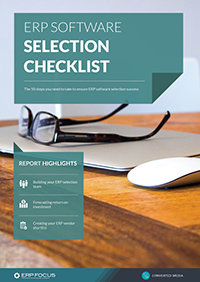ERP Shop Floor Data
Shop floor data in ERP is susceptible to overpromising during the sales cycle and under delivering after implementation. The problem has nothing to do with ERP; shop floor data management systems have been around for decades, and ERP has far more robust capabilities to facilitate manufacturing information than most legacy or stand alone packages. The challenge with shop floor data is that someone or something has to collect and report it accurately, and any past problems you had with that are not going to change as a result of installing ERP.
There are three decisions you need to make before you set any organizational expectations about shop floor data: (1) What is it, exactly, I need to monitor? (2) Who or what is going to enter that information in the system accurately and (3) Who is going to use the information, and in what format?
The key word in the first decision is “need”; most manufacturing organizations want an infinite amount of information. You should not compromise on what you need; it will be a long time before this much money and this much support is being invested in information technology again. But before adding new shop floor data to an ERP design, you should ask the question, “If this data is important, why am I not already collecting it?”
How Does Data Enter the System?
Deciding who or what is going to feed shop floor data to your ERP system is the single biggest determinate to how well your manufacturing execution system performs. Any time you can cost effectively obtain shop floor data through automated monitoring devices, the better everything works. When humans are required to report shop floor data, reliability diminishes. This is not because humans are incompetent, it is because people on a manufacturing floor continually must choose between conflicting priorities, and depending on your organization’s culture, shop floor data may be a low priority. The unfortunate paradox is that data input processes are designed around things running smoothly. So when there are problems, and you need data most, the process is most likely to fail.
Once the shop floor data is in ERP, is it easily accessible and comprehensible to decision makers? Or must it be combined with other information, or manipulated through a data analysis tool? If you are utilizing new information, is the user capable of understanding the context of the information? For instance, if you begin monitoring work in inventory, is the nominal quantity really meaningful, or is the critical measure throughput hours represented?
There is nothing that helps manufacturing be more effective than reliable information about the right things. Good ERP shop floor data ultimately helps customer service as well, because they can check the status of in process orders, and give confident responses to the customer. As long as you avoid the fallacy of believing that ERP will somehow magically know what is happening on the shop floor, you will be better off.
Free white paper

Shop Floor Data: Are You Using its Full Potential?

Featured white papers
-

ERP Software Pricing Guide
Get the latest pricing information on over 80 popular ERP systems, and learn how to budget for your ERP project in our free guide
Download -

60-Step ERP Selection Checklist
Get the comprehensive checklist for your ERP selection project
Download -

ERP Implementation: 9 steps to success
The 9 proven steps you should follow when implementing ERP
Download


